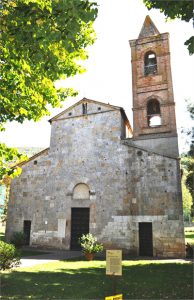 Titolare: San Marco Evangelista
Titolare: San Marco Evangelista
Unità Pastorale di San Giuliano Terme
Indirizzo della parrocchia: Via Statale Abetone, 80 – Rigoli; 56017 San Giuliano Terme (PI)
PARROCO: GRZYWACZ Mons. TOMASZ
Abitazione del parroco: Via Matteotti, 29 – Gello 56017 San Giuliano Terme (PI)
Telefono del parroco: +39.366.2447198 (WhatsApp)
E-mail del parroco: padretomasz@gmail.com
SACERDOTE COLLABORATORE: DZRAMEDO Don GIUSEPPE
Abitazione del sacerdote: Via Cellini, 3 – 56017 Orzignano 56017 San Giuliano Terme (PI)
Telefono del Sacerdote: +39.3716134943 (WhatsApp)
E-mail del sacerdote: jephlorenzo2@outlook.fr
| S. Messe a San Marco Evangelista in Rigoli | ||||||
| Lunedì | Martedì | Mercoledì | Giovedì | Venerdì | Sabato | Domenica |
| 8:00 |
Posta sull’antica via Aemilia Scauri e probabilmente già esistente nell’VIII secolo, la pieve è una delle chiese più antiche dell’Arcidiocesi pisana. Sono numerose le attestazioni arcivescovili, pontificie e imperiali che datano la sua presenza nel 1001. Originariamente la chiesa era dedicata a San Pietro e solo nel 1561 assunse l’attuale intitolazione a San Marco Evangelista. Nel corso dei secoli la chiesa, sia per cause naturali che per attacchi bellici, subì vari restauri, in modo particolare nel XVII secolo. Nel 1764 fu ricostruita in laterizio la torre campanaria che era stata abbattuta nel 1404 dal passaggio delle truppe fiorentine. Nei primi due decenni del XX secolo la struttura fu interamente sottoposta a restauro in modo da riappropriarsi della originaria struttura romanica. All’interno la chiesa, coperta da un tetto a capriate lignee, si presenta suddivisa in tre navate che culminano nelle tre absidi. Nella navata sinistra è collocata un’antica vasca battesimale opera di maestranze longobarde attive a Pisa e Lucca tra VIII e IX secolo. Nell’abside della navata sinistra si trova una copia della Madonna delle Grazie di Turino Vanni degli inizi del XV sec. ( l’originale è conservato nel Museo di San Matteo)
********************
Located on the ancient Via Aemilia Scauri and probably already existing in the 8th century, the parish church is one of the oldest churches in the Pisan Archdiocese. There are numerous archiepiscopal, papal and imperial records attesting its existence back to 1001. Originally, the church was dedicated to St Peter and it was only in 1561 that it was renamed after St Mark the Evangelist. Over the centuries, the church underwent several restorations, most notably in the 17th century, due to both natural causes and wartime attacks. In 1764 the bell tower, following ist demolition in 1404 by Florentine troops, was rebuilt in brick.
In the first two decades of the 20th century, the structure was entirely restored to its original Romanesque structure. Covered by a wooden truss roof, the church inside is divided into three naves culminating in three apses. On the left aisle, we find an ancient baptismal font attributed to the work of Lombard craftsmen active
in Pisa and Lucca between the 8th and 9th centuries. In the apse of the left aisle, we find a copy of Our Lady of Grace by Turino Vanni dating back from the beginning of the 15th century (the original is kept in the National Museum of S. Matteo in Pisa)
.
********************
Ciekawa książka: Ks. Wojciech Zyzak „Dorothy Day. Życie – Działalność – Duchowość”, Warszawa 2022.







